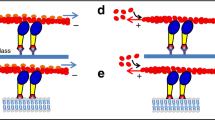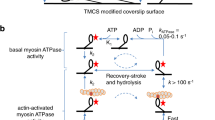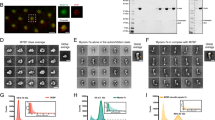Abstract
Myosin X is an unconventional myosin with puzzling motility properties. We studied the motility of dimerized myosin X using the single-molecule fluorescence techniques polTIRF, FIONA and Parallax to measure the rotation angles and three-dimensional position of the molecule during its walk. It was found that Myosin X steps processively in a hand-over-hand manner following a left-handed helical path along both single actin filaments and bundles. Its step size and velocity are smaller on actin bundles than individual filaments, suggesting myosin X often steps onto neighboring filaments in a bundle. The data suggest that a previously postulated single α-helical domain mechanically extends the lever arm, which has three IQ motifs, and either the neck-tail hinge or the tail is flexible. These structural features, in conjunction with the membrane- and microtubule-binding domains, enable myosin X to perform multiple functions on varied actin structures in cells.
This is a preview of subscription content, access via your institution
Access options
Subscribe to this journal
Receive 12 print issues and online access
$189.00 per year
only $15.75 per issue
Buy this article
- Purchase on Springer Link
- Instant access to full article PDF
Prices may be subject to local taxes which are calculated during checkout






Similar content being viewed by others
References
Berg, J.S., Derfler, B.H., Pennisi, C.M., Corey, D.P. & Cheney, R.E. Myosin-X, a novel myosin with pleckstrin homology domains, associates with regions of dynamic actin. J. Cell Sci. 113, 3439–3451 (2000).
Berg, J.S. & Cheney, R.E. Myosin-X is an unconventional myosin that undergoes intrafilopodial motility. Nat. Cell Biol. 4, 246–250 (2002).
Tokuo, H. & Ikebe, M. Myosin X transports Mena/VASP to the tip of filopodia. Biochem. Biophys. Res. Commun. 319, 214–220 (2004).
Zhang, H. et al. Myosin-X provides a motor-based link between integrins and the cytoskeleton. Nat. Cell Biol. 6, 523–531 (2004).
Sousa, A.D. & Cheney, R.E. Myosin-X: a molecular motor at the cell's fingertips. Trends Cell Biol. 15, 533–539 (2005).
Bohil, A.B., Robertson, B.W. & Cheney, R.E. Myosin-X is a molecular motor that functions in filopodia formation. Proc. Natl. Acad. Sci. USA 103, 12411–12416 (2006).
Nagy, S. et al. A myosin motor that selects bundled actin for motility. Proc. Natl. Acad. Sci. USA 105, 9616–9620 (2008).
Kovacs, M., Wang, F. & Sellers, J.R. Mechanism of action of myosin X, a membrane-associated molecular motor. J. Biol. Chem. 280, 15071–15083 (2005).
Zhu, X.-J. et al. Myosin X regulates netrin receptors and functions in axonal path-finding. Nat. Cell Biol. 9, 184–192 (2007).
Pi, X. et al. Sequential roles for myosin-X in BMP6-dependent filopodial extension, migration, and activation of BMP receptors. J. Cell Biol. 179, 1569–1582 (2007).
Weber, K.L., Sokac, A.M., Berg, J.S., Cheney, R.E. & Bement, W.M. A microtubule-binding myosin required for nuclear anchoring and spindle assembly. Nature 431, 325–329 (2004).
Toyoshima, F. & Nishida, E. Integrin-mediated adhesion orients the spindle parallel to the substratum in an EB1- and myosin X-dependent manner. EMBO J. 26, 1487–1498 (2007).
Woolner, S., O'Brien, L.L., Wiese, C. & Bement, W.M. Myosin-10 and actin filaments are essential for mitotic spindle function. J. Cell Biol. 182, 77–88 (2008).
Wühr, M., Mitchison, T.J. & Field, C.M. Mitosis: new roles for myosin-X and actin at the spindle. Curr. Biol. 18, R912–914 (2008).
Tokuo, H., Mabuchi, K. & Ikebe, M. The motor activity of myosin-X promotes actin fiber convergence at the cell periphery to initiate filopodia formation. J. Cell Biol. 179, 229–238 (2007).
Knight, P.J. et al. The predicted coiled-coil domain of myosin 10 forms a novel elongated domain that lengthens the head. J. Biol. Chem. 280, 34702–34708 (2005).
Park, H. et al. Full-length myosin VI dimerizes and moves processively along actin filaments upon monomer clustering. Mol. Cell 21, 331–336 (2006).
Homma, K. & Ikebe, M. Myosin X is a high duty ratio motor. J. Biol. Chem. 280, 29381–29391 (2005).
Homma, K., Saito, J., Ikebe, R. & Ikebe, M. Motor function and regulation of myosin X. J. Biol. Chem. 276, 34348–34354 (2001).
Sun, Y. et al. Myosin VI walks “wiggly” on actin with large and variable tilting. Mol. Cell 28, 954–964 (2007).
Forkey, J.N., Quinlan, M.E. & Goldman, Y.E. Protein structural dynamics by single-molecule fluorescence polarization. Prog. Biophys. Mol. Biol. 74, 1–35 (2000).
Rosenberg, S.A., Quinlan, M.E., Forkey, J.N. & Goldman, Y.E. Rotational motions of macromolecules by single-molecule fluorescence microscopy. Acc. Chem. Res. 38, 583–593 (2005).
Forkey, J.N., Quinlan, M.E., Shaw, M.A., Corrie, J.E.T. & Goldman, Y.E. Three-dimensional structural dynamics of myosin V by single-molecule fluorescence polarization. Nature 422, 399–404 (2003).
Yildiz, A. et al. Myosin V walks hand-over-hand: single fluorophore imaging with 1.5-nm localization. Science 300, 2061–2065 (2003).
Sun, Y., Dawicki McKenna, J.M., Murray, J.M., Ostap, E.M. & Goldman, Y.E. Parallax: high accuracy three-dimensional single molecule tracking using split images. Nano Lett. 9, 2676–2682 (2009).
Rock, R.S. et al. A flexible domain is essential for the large step size and processivity of myosin VI. Mol. Cell 17, 603–609 (2005).
Beausang, J.F., Sun, Y., Quinlan, M.E., Forkey, J.N. & Goldman, Y.E. Single molecule fluorescence polarization via polarized total internal reflection fluorescent microscopy. in Single-Molecule Techniques: A Laboratory Manual (eds. Selvin, P.R. & Ha, T.) 121–148 (Cold Spring Harbor Laboratory, Cold Spring Harbor, New York, USA, 2007).
Ökten, Z., Churchman, L.S., Rock, R.S. & Spudich, J.A. Myosin VI walks hand-over-hand along actin. Nat. Struct. Mol. Biol. 11, 884–887 (2004).
Yildiz, A. et al. Myosin VI steps via a hand-over-hand mechanism with its lever arm undergoing fluctuations when attached to actin. J. Biol. Chem. 279, 37222–37226 (2004).
Ishikawa, R., Sakamoto, T., Ando, T., Higashi-Fujime, S. & Kohama, K. Polarized actin bundles formed by human fascin-1: their sliding and disassembly on myosin II and myosin V in vitro. J. Neurochem. 87, 676–685 (2003).
Vilfan, A. Elastic lever-arm model for myosin V. Biophys. J. 88, 3792–3805 (2005).
Lan, G. & Sun, S.X. Flexible light-chain and helical structure of F-actin explain the movement and step size of myosin-VI. Biophys. J. 91, 4002–4013 (2006).
Beausang, J.F., Schroeder, H.W. III, Nelson, P.C. & Goldman, Y.E. Twirling of actin by myosins II and V observed via polarized TIRF in a modified gliding assay. Biophys. J. 95, 5820–5831 (2008).
Sako, Y., Minoguchi, S. & Yanagida, T. Single-molecule imaging of EGFR signalling on the surface of living cells. Nat. Cell Biol. 2, 168–172 (2000).
Ali, M.Y. et al. Myosin V is a left-handed spiral motor on the right-handed actin helix. Nat. Struct. Biol. 9, 464–467 (2002).
Arsenault, M.E., Sun, Y., Bau, H.H. & Goldman, Y.E. Using electrical and optical tweezers to facilitate studies of molecular motors. Phys. Chem. Chem. Phys. 11, 4834–4839 (2009).
Arsenault, M.E., Zhao, H., Purohit, P.K., Goldman, Y.E. & Bau, H.H. Confinement and manipulation of actin filaments by electric fields. Biophys. J. 93, L42–L44 (2007).
Mukherjea, M. et al. Myosin VI dimerization triggers an unfolding of a three-helix bundle in order to extend its reach. Mol. Cell 35, 305–315 (2009).
Rock, R.S. et al. Myosin VI is a processive motor with a large step size. Proc. Natl. Acad. Sci. USA 98, 13655–13659 (2001).
Choe, S. & Sun, S.X. The elasticity of α-helices. J. Chem. Phys. 122, 244912 (2005).
Baboolal, T.G. et al. The SAH domain extends the functional length of the myosin lever. Proc. Natl. Acad. Sci. USA 106, 22193–22198 (2009).
Li, X.-D., Jung, H.S., Mabuchi, K., Craig, R. & Ikebe, M. The globular tail domain of myosin Va functions as an inhibitor of the myosin Va motor. J. Biol. Chem. 281, 21789–21798 (2006).
Thirumurugan, K., Sakamoto, T., Hammer, J.A. III, Sellers, J.R. & Knight, P.J. The cargo-binding domain regulates structure and activity of myosin 5. Nature 442, 212–215 (2006).
Yu, C. et al. Myosin VI undergoes cargo-mediated dimerization. Cell 138, 537–548 (2009).
Phichith, D. et al. Cargo binding induces dimerization of myosin VI. Proc. Natl. Acad. Sci. USA 106, 17320–17324 (2009).
Iwaki, M. et al. Cargo-binding makes a wild-type single-headed myosin-VI move processively. Biophys. J. 90, 3643–3652 (2006).
Kerssemakers, J.W. et al. Assembly dynamics of microtubules at molecular resolution. Nature 442, 709–712 (2006).
Corrie, J.E.T., Craik, J.S. & Munasinghe, V.R.N. A homobifunctional rhodamine for labeling proteins with defined orientations of a fluorophore. Bioconjug. Chem. 9, 160–167 (1998).
Dunn, A.R. & Spudich, J.A. Dynamics of the unbound head during myosin V processive translocation. Nat. Struct. Mol. Biol. 14, 246–248 (2007).
Pardee, J.D. & Spudich, J.A. Purification of muscle actin. Methods Cell Biol. 24, 271–289 (1982).
Homma, K., Saito, J., Ikebe, R. & Ikebe, M. Ca2+-dependent regulation of the motor activity of myosin V. J. Biol. Chem. 275, 34766–34771 (2000).
Harada, Y., Sakurada, K., Aoki, T., Thomas, D.D. & Yanagida, T. Mechanochemical coupling in actomyosin energy transduction studied by in vitro movement assay. J. Mol. Biol. 216, 49–68 (1990).
Michel, B. et al. Printing meets lithography: soft approaches to high-resolution printing. IBM J. Res. Develop. 45, 697–719 (2001).
Schmid, H. & Michel, B. Siloxane polymers for high-resolution, high-accuracy soft lithography. Macromolecules 33, 3042–3049 (2000).
Nitzsche, B., Ruhnow, F. & Diez, S. Quantum-dot-assisted characterization of microtubule rotations during cargo transport. Nat. Nanotechnol. 3, 552–556 (2008).
Abramoff, M.D., Magelhaes, P.J. & Ram, S.J. Image processing with ImageJ. Biophotonics Int. 11, 36–42 (2004).
Acknowledgements
We acknowledge discussion and comments by J.H. Lewis and J.F. Beausang. We thank T.M. Svitkina and C. Yang for characterization of fascin-bundled actin by electron microscopy (US National Institutes of Health (NIH) grant RR 22482) and K. Homma (University of Massachusetts Medical School) for the GFP–Myosin X HMM construct. Bifunctional rhodamine (BR-I2) was a generous gift from J.E.T. Corrie (UK Medical Research Council National Institute for Medical Research). This work was supported by US National Science Foundation Nanoscale Science and Engineering Center grant DMR-0425780 through the Nano/Bio Interface Center and NIH grant GM086352.
Author information
Authors and Affiliations
Corresponding author
Ethics declarations
Competing interests
The authors declare no competing financial interests.
Supplementary information
Supplementary Text and Figures
Supplementary Figures 1–5 and Supplementary Table 1 (PDF 947 kb)
Rights and permissions
About this article
Cite this article
Sun, Y., Sato, O., Ruhnow, F. et al. Single-molecule stepping and structural dynamics of myosin X. Nat Struct Mol Biol 17, 485–491 (2010). https://doi.org/10.1038/nsmb.1785
Received:
Accepted:
Published:
Issue Date:
DOI: https://doi.org/10.1038/nsmb.1785
This article is cited by
-
Membrane-bound myosin IC drives the chiral rotation of the gliding actin filament around its longitudinal axis
Scientific Reports (2023)
-
Filopodia rotate and coil by actively generating twist in their actin shaft
Nature Communications (2022)
-
Activated full-length myosin-X moves processively on filopodia with large steps toward diverse two-dimensional directions
Scientific Reports (2017)
-
Myosin X is recruited to nascent focal adhesions at the leading edge and induces multi-cycle filopodial elongation
Scientific Reports (2017)



